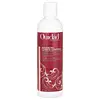Not Your Mother’s Curl Talk Flash Freeze Gel Versus Ouidad Advanced Climate Control Heat & Humidity Gel
What's inside
What's inside
 Key Ingredients
Key Ingredients

No key ingredients
 Benefits
Benefits

 Concerns
Concerns

 Ingredients Side-by-side
Ingredients Side-by-side

Water
Skin ConditioningPolyquaternium-69
Pvp
Emulsion StabilisingAcrylates/Steareth-20 Methacrylate Crosspolymer
Glycerin
HumectantKeratin Amino Acids
Skin ConditioningOryza Sativa Extract
AbsorbentLactobacillus/Tomato Fruit Ferment Extract
Skin ConditioningLeuconostoc/Radish Root Ferment Filtrate
AntimicrobialAcyl Coenzyme A Desaturase
Skin ConditioningParfum
MaskingTetrasodium EDTA
Phenoxyethanol
PreservativeEthylhexylglycerin
Skin ConditioningSodium Hydroxide
BufferingWater, Polyquaternium-69, Pvp, Acrylates/Steareth-20 Methacrylate Crosspolymer, Glycerin, Keratin Amino Acids, Oryza Sativa Extract, Lactobacillus/Tomato Fruit Ferment Extract, Leuconostoc/Radish Root Ferment Filtrate, Acyl Coenzyme A Desaturase, Parfum, Tetrasodium EDTA, Phenoxyethanol, Ethylhexylglycerin, Sodium Hydroxide
Water
Skin ConditioningGlycerin
HumectantPolyquaternium-11
PEG-75 Shea Butter Glycerides
EmulsifyingSericin
Skin ConditioningWheat Amino Acids
Skin ConditioningHydrolyzed Wheat Protein/Pvp Crosspolymer
Polyquaternium-59
UV AbsorberPolyquaternium-10
PEG-60 Almond Glycerides
EmulsifyingChamomilla Recutita Flower Extract
MaskingCassia Auriculata Leaf Extract
Skin ConditioningActinidia Chinensis Fruit Extract
EmollientTocopheryl Acetate
AntioxidantRetinyl Palmitate
Skin ConditioningPanthenol
Skin ConditioningGuar Hydroxypropyltrimonium Chloride
Skin ConditioningPolyquaternium-7
Behentrimonium Chloride
PreservativeCetrimonium Chloride
AntimicrobialPolysorbate 20
EmulsifyingDisodium EDTA
Citric Acid
BufferingPotassium Sorbate
PreservativeButylene Glycol
HumectantHexylene Glycol
EmulsifyingCaprylyl Glycol
EmollientEthylhexylglycerin
Skin ConditioningPhenoxyethanol
PreservativeParfum
MaskingAlpha-Isomethyl Ionone
PerfumingBenzyl Benzoate
AntimicrobialBenzyl Salicylate
PerfumingCitronellol
PerfumingHexyl Cinnamal
PerfumingHydroxycitronellal
PerfumingLimonene
PerfumingLinalool
PerfumingWater, Glycerin, Polyquaternium-11, PEG-75 Shea Butter Glycerides, Sericin, Wheat Amino Acids, Hydrolyzed Wheat Protein/Pvp Crosspolymer, Polyquaternium-59, Polyquaternium-10, PEG-60 Almond Glycerides, Chamomilla Recutita Flower Extract, Cassia Auriculata Leaf Extract, Actinidia Chinensis Fruit Extract, Tocopheryl Acetate, Retinyl Palmitate, Panthenol, Guar Hydroxypropyltrimonium Chloride, Polyquaternium-7, Behentrimonium Chloride, Cetrimonium Chloride, Polysorbate 20, Disodium EDTA, Citric Acid, Potassium Sorbate, Butylene Glycol, Hexylene Glycol, Caprylyl Glycol, Ethylhexylglycerin, Phenoxyethanol, Parfum, Alpha-Isomethyl Ionone, Benzyl Benzoate, Benzyl Salicylate, Citronellol, Hexyl Cinnamal, Hydroxycitronellal, Limonene, Linalool
 Reviews
Reviews

Ingredients Explained
These ingredients are found in both products.
Ingredients higher up in an ingredient list are typically present in a larger amount.
Ethylhexylglycerin (we can't pronounce this either) is commonly used as a preservative and skin softener. It is derived from glyceryl.
You might see Ethylhexylglycerin often paired with other preservatives such as phenoxyethanol. Ethylhexylglycerin has been found to increase the effectiveness of these other preservatives.
Glycerin is already naturally found in your skin. It helps moisturize and protect your skin.
A study from 2016 found glycerin to be more effective as a humectant than AHAs and hyaluronic acid.
As a humectant, it helps the skin stay hydrated by pulling moisture to your skin. The low molecular weight of glycerin allows it to pull moisture into the deeper layers of your skin.
Hydrated skin improves your skin barrier; Your skin barrier helps protect against irritants and bacteria.
Glycerin has also been found to have antimicrobial and antiviral properties. Due to these properties, glycerin is often used in wound and burn treatments.
In cosmetics, glycerin is usually derived from plants such as soybean or palm. However, it can also be sourced from animals, such as tallow or animal fat.
This ingredient is organic, colorless, odorless, and non-toxic.
Glycerin is the name for this ingredient in American English. British English uses Glycerol/Glycerine.
Learn more about GlycerinParfum is a catch-all term for an ingredient or more that is used to give a scent to products.
Also called "fragrance", this ingredient can be a blend of hundreds of chemicals or plant oils. This means every product with "fragrance" or "parfum" in the ingredients list is a different mixture.
For instance, Habanolide is a proprietary trade name for a specific aroma chemical. When used as a fragrance ingredient in cosmetics, most aroma chemicals fall under the broad labeling category of “FRAGRANCE” or “PARFUM” according to EU and US regulations.
The term 'parfum' or 'fragrance' is not regulated in many countries. In many cases, it is up to the brand to define this term.
For instance, many brands choose to label themselves as "fragrance-free" because they are not using synthetic fragrances. However, their products may still contain ingredients such as essential oils that are considered a fragrance by INCI standards.
One example is Calendula flower extract. Calendula is an essential oil that still imparts a scent or 'fragrance'.
Depending on the blend, the ingredients in the mixture can cause allergies and sensitivities on the skin. Some ingredients that are known EU allergens include linalool and citronellol.
Parfum can also be used to mask or cover an unpleasant scent.
The bottom line is: not all fragrances/parfum/ingredients are created equally. If you are worried about fragrances, we recommend taking a closer look at an ingredient. And of course, we always recommend speaking with a professional.
Learn more about ParfumPhenoxyethanol is a preservative that has germicide, antimicrobial, and aromatic properties. Studies show that phenoxyethanol can prevent microbial growth. By itself, it has a scent that is similar to that of a rose.
It's often used in formulations along with Caprylyl Glycol to preserve the shelf life of products.
Water. It's the most common cosmetic ingredient of all. You'll usually see it at the top of ingredient lists, meaning that it makes up the largest part of the product.
So why is it so popular? Water most often acts as a solvent - this means that it helps dissolve other ingredients into the formulation.
You'll also recognize water as that liquid we all need to stay alive. If you see this, drink a glass of water. Stay hydrated!
Learn more about Water